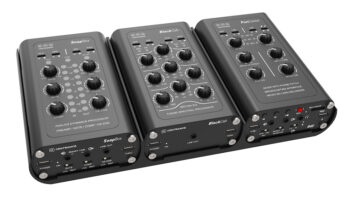
We know what kind of clothes Egyptian pharaohs wore because their paintings and writings have lasted to this day. We know that the Babylonians were way into beer because they engraved that information in stone tablets. We even know what kind of animals existed 20,000 years ago thanks to the Paleolithic cave paintings in Lascaux, France.
But we have no idea what kind of music any of those people played.
All we have is some sketchy ideas of their instruments. We don’t even know for certain what Bach’s Brandenburgs sounded like. Yes, there was notation. But some believe that later baroque music had an inherent, subtle swing that wasn’t notated because it was a given.
Thankfully, recording has kept modern musical history from slip slidin’ away. We know what operatic tenors like Enrico Caruso sounded like thanks to gramophone recordings of the early 20th century. We can hear how the London Symphony Orchestra, conducted by the legendary Artur Nikisch, interpreted Beethoven’s Fifth Symphony more than a century ago. And Elvis lives—or at least his music does.
We have gone from millennia where music existed only for the moment to an era where every piece of music can be frozen in time, blasted out into the world through venues like YouTube and Spotify.
A LITTLE LTO
But digital data isn’t stone tablets. Will people 20,000 years from now—or even 1,000 years from now—know what kind of music we made? We’ve already seen the CD’s arc, from primary music playback medium to streaming’s poor relative. Sure, you can still buy audiophile CD players—but I suspect playing back a CD in 2121 will be challenging.
Fortunately, preserving music as digital data means it can be converted, transformed and refreshed. The P&E Wing of NARAS has studied archival storage and recommends industry-standard LTO (Linear-Tape Open) cartridges. LTO is supported by heavy hitters like Hewlett-Packard, IBM, Quantum, FujiFilm, Sony and others, so it’s not going anywhere. The standard Ultrium cartridge using the just-introduced LTO-9 format (the number is the current generation) can hold 18 TB of uncompressed data, and typically twice as much compressed data. The LTO-8 generation in common use stores up to 12 TB uncompressed.
Open Channel: Who’s Right? Who’s Wrong? Who Cares?
Open Channel: How the Loudness Wars Turned Guerrilla
Open Channel: To Get the Right Answer…Ask the Right Question
The LTO.org site has a roadmap for future LTO formats—until now, there’s been about three years between generations. LTO-10 is expected to store up to 36 TB uncompressed, with 72 TB for LTO-11 and 144 TB for LTO-12. Keep in mind that LTO-8 tape is only about $6 per terabyte (for comparison, an 18 TB Seagate hard drive is around $22 per terabyte). LTO is the best we have now, but it’s not perfect. The storage environment is crucial, because any contamination is fatal to such incredibly thin tape.
Also, consider compatibility limitations. Generations 1 – 7 can read tapes from two prior generations, and write to the previous generation. LTO- 8 and 9 restrict reading and writing to only the current and previous generations. And although tape costs are low, a single LTO-8 drive costs $3,000-$4,000; a dual-drive is more than $7k. The more data you need to store, the more cost-effective LTO becomes.
BUT WHAT ABOUT THE CLOUD?
Cloud storage is relatively convenient, fast and secure. But local storage isn’t subject to the ransomware that plagues connected or cloud storage. That’s a huge deal for major corporations that need to safeguard sensitive data. And an X-class solar flare of the same magnitude as the 1859 Carrington Storm would cause massive damage to the grid and any electronics that haven’t been hardened.
If all our musical history is stored in the cloud, it could disappear in literally a few seconds—although, admittedly, we’d have far more serious problems, like nuclear reactors melting down and not being able to eat. (Side note: I’m amazed that the federal government hasn’t allocated the couple billion dollars needed to harden the grid against flares and EMPs, especially considering the National Science Foundation and NASA believe an occurrence of the same magnitude is about “when,” not “if.”)
So NARAS made the right decision for archival storage, at least for the next several decades. But not all studios need to back up Petabytes (1,000 Terabytes) of data, and LTO becomes less cost-effective when you take the drive, storage and refreshing into account. For example, my business uses Blu-ray for archival backup of modest amounts of data. Today, 25 GB and 100 GB discs are around $1 and $10, respectively, far more robust than DVDs, have at least a 30-year shelf life, and aren’t too fussy about their storage environment.
For multiple terabytes of data, hard drive backup to at least two drives, with periodic refreshes to new drives, works well. SSDs are viable, too, but bear in mind that they’re more sensitive to electrical issues. Of course, the cloud can provide a holding tank for data, prior to archiving.
So it looks like our musical history won’t be slip slidin’ away, as long as we keep refreshing our digital data to whatever can read it back. People in the 23rd century will almost certainly be able to know what pop music from the 20th century sounded like.
I wonder what they’ll think of GWAR…







